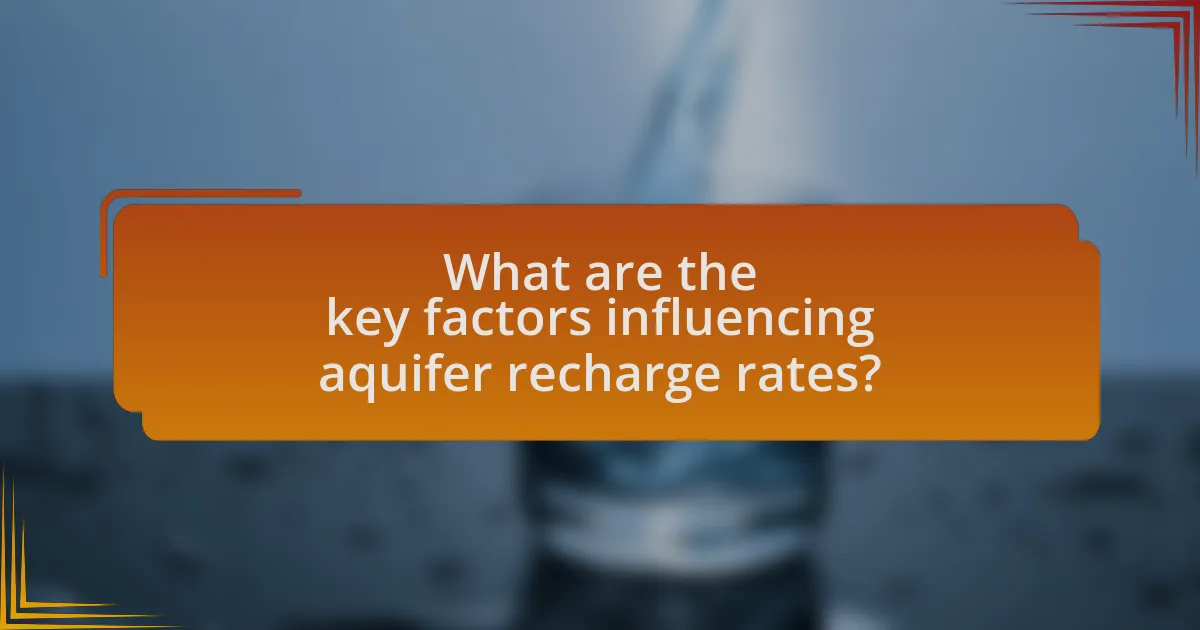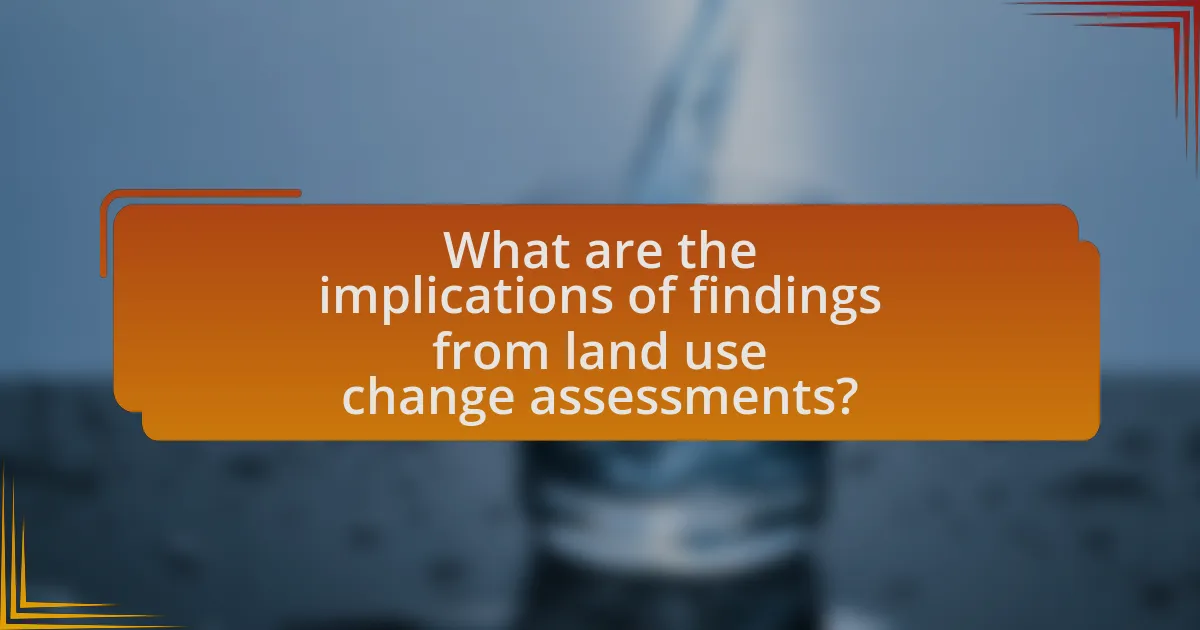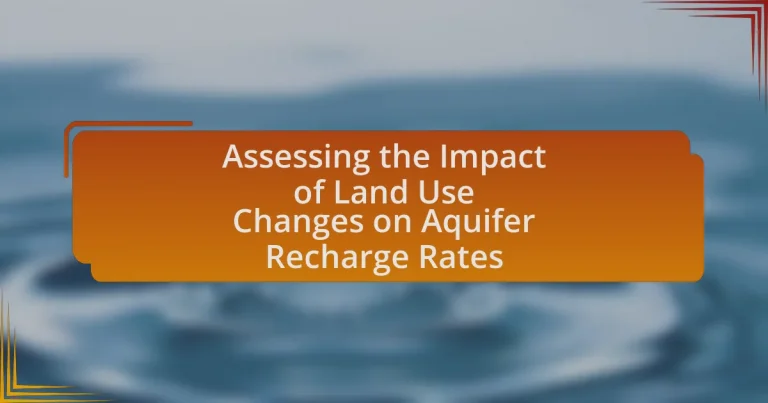The article focuses on assessing the impact of land use changes on aquifer recharge rates, highlighting key factors such as precipitation, soil permeability, land use practices, vegetation cover, and topography. It examines how urbanization and agricultural expansion influence these rates, often leading to reduced groundwater availability and increased environmental challenges. Methodologies for evaluating these impacts include remote sensing, GIS, and hydrological modeling, which provide essential data for informed decision-making in land management. The article emphasizes the importance of sustainable practices and community engagement in mitigating negative effects on aquifer recharge, ensuring the protection of vital water resources.
What are the key factors influencing aquifer recharge rates?

The key factors influencing aquifer recharge rates include precipitation, soil permeability, land use practices, vegetation cover, and topography. Precipitation directly contributes to the amount of water available for recharge, while soil permeability determines how quickly water can infiltrate the ground. Land use practices, such as urbanization and agriculture, can either enhance or hinder recharge by altering the natural landscape and water flow. Vegetation cover plays a role in intercepting rainfall and promoting infiltration, and topography affects the movement of water across the land surface. Studies have shown that areas with higher vegetation cover and permeable soils experience greater recharge rates, highlighting the importance of these factors in managing aquifer sustainability.
How do land use changes affect these factors?
Land use changes significantly affect aquifer recharge rates by altering the natural hydrological processes. For instance, urbanization increases impervious surfaces, which reduces water infiltration and consequently decreases recharge rates. Studies indicate that areas with extensive agricultural practices can either enhance or diminish recharge depending on the type of crops and land management practices employed. Research shows that deforestation leads to reduced soil moisture and increased runoff, further impairing aquifer recharge. Therefore, the transformation of land use directly influences the availability and sustainability of groundwater resources.
What specific land use changes are most impactful on aquifer recharge?
Urbanization and agricultural expansion are the specific land use changes most impactful on aquifer recharge. Urbanization increases impervious surfaces, such as roads and buildings, which reduces the infiltration of water into the ground, thereby decreasing aquifer recharge rates. Agricultural expansion often involves the conversion of natural landscapes into cropland, which can lead to soil compaction and the use of irrigation practices that may not promote natural recharge. Studies have shown that areas with high levels of impervious surfaces can experience a reduction in groundwater recharge by up to 50% compared to natural landscapes.
How do urbanization and agriculture differ in their effects on recharge rates?
Urbanization and agriculture differ significantly in their effects on aquifer recharge rates, primarily due to land cover changes and water management practices. Urbanization typically leads to increased impervious surfaces, such as roads and buildings, which reduce the infiltration of water into the ground, thereby decreasing recharge rates. In contrast, agricultural practices often involve land management techniques that can enhance recharge, such as the use of cover crops and conservation tillage, which promote soil permeability and water retention. Studies have shown that urban areas can reduce recharge rates by up to 50% compared to natural landscapes, while well-managed agricultural systems can maintain or even improve recharge rates by facilitating water infiltration through soil amendments and sustainable practices.
Why is it important to assess the impact of land use changes?
Assessing the impact of land use changes is crucial because it directly influences environmental sustainability and resource management. Changes in land use can alter hydrological cycles, affecting aquifer recharge rates, which are vital for maintaining water supply. For instance, urbanization typically increases impervious surfaces, leading to reduced groundwater infiltration and lower aquifer recharge. Studies have shown that areas with increased agricultural practices can either enhance or diminish recharge rates depending on the methods used, highlighting the need for careful evaluation. Understanding these impacts allows for informed decision-making in land management, ensuring the protection of water resources and ecosystem health.
What are the potential consequences of reduced aquifer recharge?
Reduced aquifer recharge can lead to significant consequences such as decreased water availability, increased groundwater salinity, and land subsidence. Decreased water availability occurs because aquifers serve as crucial sources of freshwater for drinking, irrigation, and industrial use; when recharge rates decline, the volume of water stored in aquifers diminishes, leading to shortages. Increased groundwater salinity happens as reduced recharge allows seawater intrusion in coastal aquifers, compromising water quality. Land subsidence can occur when excessive groundwater extraction exceeds recharge, causing the ground to sink, which can damage infrastructure and alter surface water flow. These consequences highlight the critical importance of maintaining aquifer recharge rates to ensure sustainable water resources.
How does aquifer depletion affect local ecosystems and communities?
Aquifer depletion negatively impacts local ecosystems and communities by reducing water availability for plants, animals, and human consumption. This reduction leads to diminished vegetation cover, which can result in habitat loss for wildlife and increased soil erosion. Additionally, communities reliant on aquifers for drinking water and agriculture face water scarcity, which can lead to food insecurity and economic challenges. For instance, in California’s Central Valley, over-extraction of groundwater has caused significant land subsidence, affecting infrastructure and agricultural productivity.
What methodologies are used to assess the impact of land use changes?

Methodologies used to assess the impact of land use changes include remote sensing, geographic information systems (GIS), hydrological modeling, and field surveys. Remote sensing allows for the analysis of land cover changes over time by utilizing satellite imagery, which provides quantitative data on vegetation and impervious surfaces. GIS facilitates spatial analysis and visualization of land use patterns, enabling researchers to correlate these patterns with hydrological data. Hydrological modeling simulates the effects of land use changes on water movement and aquifer recharge, providing insights into how different scenarios impact water resources. Field surveys collect empirical data on soil properties, vegetation types, and water levels, which validate findings from remote sensing and modeling approaches. These methodologies collectively enhance understanding of how land use changes influence aquifer recharge rates.
How do researchers measure aquifer recharge rates?
Researchers measure aquifer recharge rates using various methods, including water balance calculations, tracer studies, and groundwater modeling. Water balance calculations involve assessing the inputs and outputs of water in a specific area, factoring in precipitation, evaporation, and surface runoff to estimate how much water infiltrates into the aquifer. Tracer studies utilize substances like dyes or isotopes to track the movement of water through the soil and into the aquifer, providing insights into recharge rates and pathways. Groundwater modeling employs computer simulations to analyze hydrological processes and predict recharge rates based on various land use scenarios. These methods are validated through empirical data and field observations, ensuring accuracy in understanding aquifer recharge dynamics.
What tools and technologies are commonly employed in this assessment?
Commonly employed tools and technologies in assessing the impact of land use changes on aquifer recharge rates include Geographic Information Systems (GIS), remote sensing, hydrological modeling software, and groundwater monitoring systems. GIS facilitates spatial analysis and visualization of land use patterns, while remote sensing provides data on land cover changes over time. Hydrological modeling software, such as MODFLOW, simulates groundwater flow and recharge processes, allowing for predictions based on different land use scenarios. Groundwater monitoring systems, including piezometers and water level loggers, collect real-time data on aquifer levels, which is essential for validating models and understanding recharge dynamics. These tools collectively enhance the accuracy and effectiveness of assessments in this field.
How do modeling techniques contribute to understanding recharge dynamics?
Modeling techniques significantly enhance the understanding of recharge dynamics by simulating the interactions between various hydrological processes and land use changes. These techniques, such as numerical groundwater models and hydrological simulations, allow researchers to analyze how different land use scenarios affect aquifer recharge rates. For instance, studies have shown that urbanization can lead to reduced recharge due to increased impervious surfaces, which is effectively captured in models that incorporate land cover data and precipitation patterns. By providing a framework to predict the impacts of land use changes on recharge, modeling techniques facilitate informed decision-making for sustainable water resource management.
What role does data collection play in assessing land use impacts?
Data collection is essential in assessing land use impacts as it provides the quantitative and qualitative information necessary to evaluate changes in land use and their effects on environmental factors, including aquifer recharge rates. Accurate data on land cover, soil types, hydrology, and land management practices enables researchers to model and analyze how different land uses influence water infiltration and groundwater replenishment. For instance, studies have shown that urbanization can significantly reduce aquifer recharge due to increased impervious surfaces, which can be quantified through data collection methods such as remote sensing and ground surveys. This empirical evidence supports the understanding of the relationship between land use changes and their hydrological impacts, facilitating informed decision-making for sustainable land management.
What types of data are essential for accurate assessments?
Essential data for accurate assessments of aquifer recharge rates include hydrological data, land use data, soil characteristics, and climate data. Hydrological data, such as groundwater levels and streamflow measurements, provide insights into water movement and availability. Land use data, detailing changes in vegetation and urbanization, helps in understanding how these changes affect water infiltration and recharge. Soil characteristics, including permeability and texture, influence the rate at which water enters the aquifer. Climate data, encompassing precipitation patterns and temperature variations, is crucial for modeling recharge processes. Collectively, these data types enable comprehensive evaluations of how land use changes impact aquifer recharge rates.
How can remote sensing enhance our understanding of land use changes?
Remote sensing enhances our understanding of land use changes by providing comprehensive, real-time data on land cover and land use patterns. This technology utilizes satellite imagery and aerial photography to monitor changes over time, allowing researchers to analyze trends in urbanization, agriculture, deforestation, and other land use activities. For instance, studies have shown that remote sensing can detect shifts in land use with a spatial resolution of up to 30 meters, enabling the identification of specific areas undergoing change. Additionally, remote sensing data can be integrated with geographic information systems (GIS) to assess the impact of these changes on environmental factors, such as aquifer recharge rates, by correlating land use patterns with hydrological models.
What are the implications of findings from land use change assessments?

Findings from land use change assessments have significant implications for environmental management and policy-making. These assessments reveal how changes in land use, such as urbanization or agricultural expansion, affect natural resources, particularly aquifer recharge rates. For instance, studies indicate that increased impervious surfaces from urban development can lead to reduced groundwater recharge, as seen in research conducted in the United States, which found that urban areas can decrease aquifer recharge by up to 50%. Understanding these implications allows policymakers to implement strategies that mitigate negative impacts, such as promoting sustainable land use practices that enhance aquifer recharge and protect water resources.
How can policymakers use this information to promote sustainable land use?
Policymakers can use information on the impact of land use changes on aquifer recharge rates to implement regulations that protect and enhance groundwater resources. By understanding how different land use practices affect aquifer recharge, policymakers can promote sustainable practices such as maintaining vegetation cover, implementing conservation tillage, and establishing buffer zones around water bodies. Research indicates that urbanization can significantly reduce aquifer recharge by increasing impervious surfaces, which leads to runoff rather than infiltration. Therefore, integrating land use planning with water management strategies can help ensure that development does not compromise aquifer health, ultimately supporting sustainable land use and water availability for future generations.
What strategies can be implemented to mitigate negative impacts on aquifer recharge?
To mitigate negative impacts on aquifer recharge, implementing strategies such as promoting sustainable land use practices, enhancing vegetation cover, and utilizing rainwater harvesting systems is essential. Sustainable land use practices, including reduced impervious surfaces and responsible agricultural techniques, can significantly improve water infiltration rates. Enhancing vegetation cover, particularly through reforestation and afforestation, increases soil permeability and reduces runoff, allowing more water to reach aquifers. Additionally, rainwater harvesting systems capture and store precipitation, facilitating groundwater recharge. These strategies are supported by studies indicating that improved land management can lead to increased aquifer recharge rates, thereby ensuring sustainable water resources.
How can community engagement improve land use planning and aquifer protection?
Community engagement can significantly enhance land use planning and aquifer protection by incorporating local knowledge and fostering collaborative decision-making. Engaging community members allows for the identification of specific local needs and concerns regarding land use, which can lead to more effective and sustainable planning outcomes. For instance, studies have shown that areas with active community participation in land use decisions often experience better compliance with environmental regulations and improved management of natural resources. This is evidenced by the success of community-led initiatives in regions like the Chesapeake Bay, where local stakeholders have played a crucial role in implementing practices that protect aquifers and enhance water quality.
What best practices can be adopted for sustainable land use management?
Best practices for sustainable land use management include implementing integrated land use planning, promoting agroecological practices, and enhancing conservation efforts. Integrated land use planning ensures that land resources are utilized efficiently while considering environmental impacts, which is crucial for maintaining aquifer recharge rates. Agroecological practices, such as crop rotation and organic farming, improve soil health and water retention, directly benefiting aquifer recharge. Additionally, conservation efforts, including reforestation and wetland restoration, help maintain natural water cycles and protect groundwater resources. These practices are supported by studies indicating that sustainable land management can significantly enhance aquifer recharge and overall ecosystem health.
How can land use planning incorporate aquifer recharge considerations?
Land use planning can incorporate aquifer recharge considerations by integrating strategies that protect and enhance natural recharge areas. This can be achieved through zoning regulations that limit impermeable surfaces, promoting the use of permeable materials in construction, and preserving green spaces that facilitate water infiltration. Studies have shown that urban areas with increased green infrastructure, such as parks and green roofs, can significantly improve aquifer recharge rates by allowing rainwater to percolate into the ground rather than run off. For instance, a report by the U.S. Environmental Protection Agency indicates that implementing low-impact development practices can increase groundwater recharge by up to 50% in urban settings.
What role do conservation practices play in enhancing aquifer recharge rates?
Conservation practices significantly enhance aquifer recharge rates by improving soil permeability and increasing water retention. Techniques such as contour farming, cover cropping, and the establishment of buffer strips reduce surface runoff and promote infiltration of water into the ground. For instance, a study published in the Journal of Hydrology found that implementing cover crops can increase soil moisture levels by up to 30%, thereby facilitating greater aquifer recharge. Additionally, practices like rainwater harvesting capture precipitation, allowing it to percolate into the aquifer rather than evaporating or running off. These methods collectively contribute to sustainable water management and the restoration of groundwater levels.


